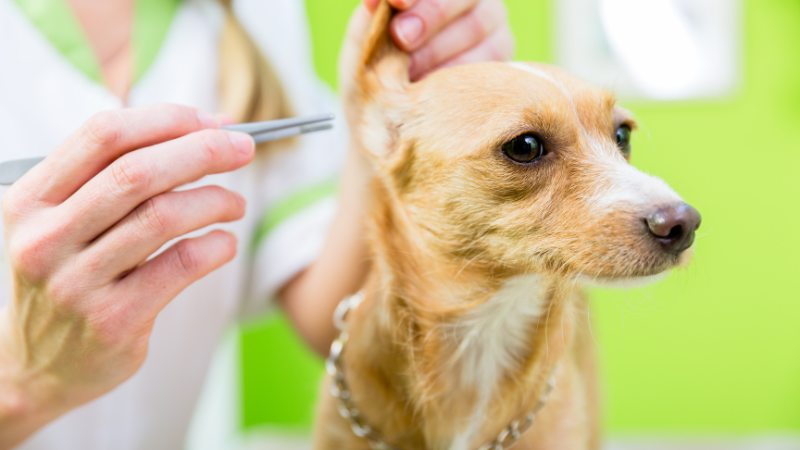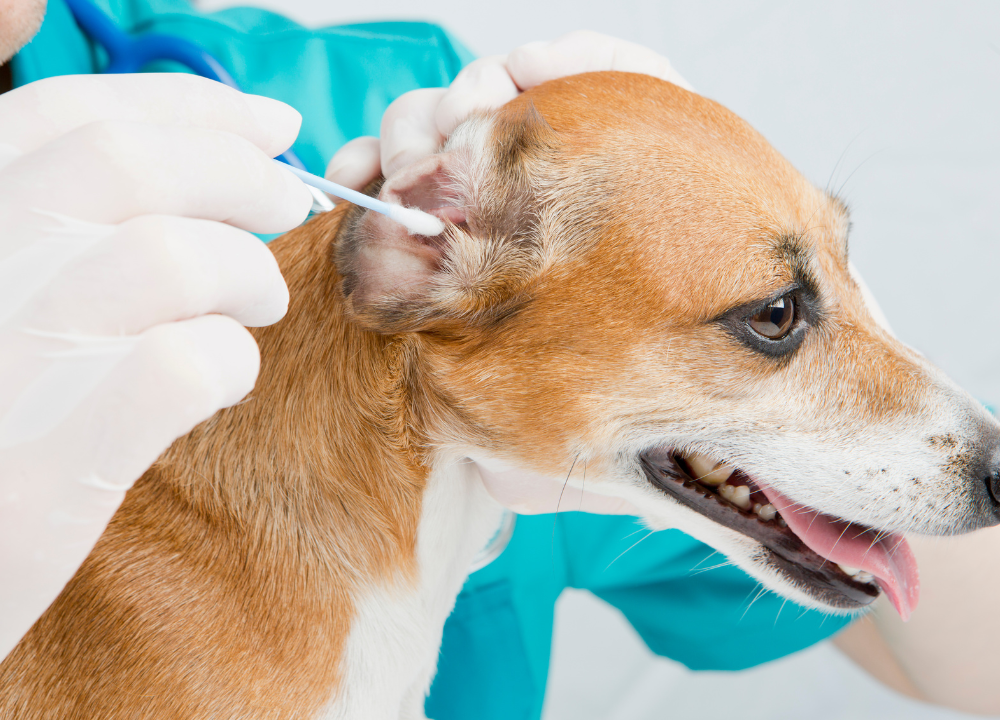Are you worried about your furry friend’s ear infection? Is your dog experiencing discomfort and pain that’s affecting their quality of life? Look no further! In this comprehensive blog, we will delve into the world of Mometamax for dogs—the ultimate solution for a swift recovery from ear infections. You’ll find everything you need to know to ensure your beloved pet gets back on their paws in no time.
Throughout this informative piece, we’ll address the most pressing concerns and pain points dog owners like yourself may have when it comes to ear infections. From understanding the causes and symptoms to exploring how Mometamax works, we’ll provide you with expert insights and tips for a successful treatment.
In this blog, we’ll cover:
1. Introduction to Mometamax and its efficacy in treating dog ear infections.
2. Common causes and symptoms of ear infections that all pet owners should be aware of.
3. Step-by-step guide on how to administer Mometamax to your dog and what to expect during the treatment process.
4. Vital tips and preventive measures to ensure a swift recovery and prevent future ear infections.
Get ready to embark on a journey of knowledge and discover why Mometamax is the go-to solution for your precious pup.
1. What is Mometamax Otic Suspension?
Mometamax Otic Suspension is a prescription medication specifically formulated for the treatment of otitis externa in dogs. Otitis externa refers to inflammation and infection of the external ear canal, a common condition among canines. This medication contains three active ingredients: gentamicin sulfate, mometasone furoate monohydrate, and clotrimazole. Each of these components plays a vital role in combating bacterial and fungal infections, reducing inflammation, and relieving associated symptoms.

(1) Gentamicin Sulfate: This antibiotic agent targets and eradicates susceptible strains of yeast and bacteria. It helps eliminate the harmful microorganisms causing the ear infection, allowing for a swift recovery and prevention of further complications.
(2) Mometasone Furoate Monohydrate: With its anti-inflammatory properties, mometasone furoate monohydrate reduces redness, swelling, and discomfort in the ear canal. By alleviating these symptoms, it provides relief and promotes healing.
(3) Clotrimazole: As an antifungal agent, clotrimazole targets fungal infections that commonly accompany bacterial ear infections. It effectively tackles fungal overgrowth, ensuring comprehensive treatment and preventing future recurrences.
The combination of these active ingredients creates a powerful formula that addresses both bacterial and fungal causes of otitis externa, thereby increasing the chances of a successful recovery. Mometamax Otic Suspension is administered directly into the affected ear canal, allowing for targeted treatment and maximum effectiveness.
Additionally, the medication is formulated with a mineral oil-based system and a plasticized hydrocarbon gel, which improve its adherence and contact time with the infected area. This enhances its efficacy and ensures optimal distribution within the ear canal for effective treatment.
It’s important to note that Mometamax Otic Suspension should only be used as prescribed by a veterinarian, and pet owners must adhere to the recommended dosage and duration of treatment. Any deviation from the prescribed course may result in incomplete resolution of the infection or development of antibiotic resistance.
💡 key Takeaway: Mometamax Otic Suspension is a prescription medication that combines gentamicin sulfate, mometasone furoate monohydrate, and clotrimazole to effectively treat otitis externa in dogs. It targets both bacterial and fungal causes of the infection, reduces inflammation, and provides relief from the associated symptoms.
2. Understanding Ear Infections in Dogs
Ear infections are a common problem among many dogs, and it is important for pet owners to have a good understanding of this condition. In this section, we will explore the causes, symptoms, and treatment options of ear infections in dogs.

Causes of Ear Infections:
Bacterial Infections: Bacteria can enter the dog’s ear canal, leading to an infection. This can happen due to factors such as excessive earwax, allergies, or moisture buildup in the ears.
Yeast Infections: Yeast organisms, particularly Malassezia, can also cause ear infections in dogs. Certain breeds with floppy ears or excessive hair are more prone to these types of infections.
Allergies: Dogs with allergies, whether it’s food allergies or environmental allergies, are more susceptible to ear infections. The inflammation caused by allergies creates an ideal environment for infections to develop.
Parasites: External parasites like mites can irritate the ear canal, leading to inflammation and secondary infections.
Symptoms of Ear Infections:
- Frequent scratching of the ears or head shaking
- Redness and swelling in the ear canal
- Foul odor coming from the ears
- Discharge or fluid buildup
- Sensitivity or pain when you touch the ears
- Partial hearing loss or a head tilt
- Loss of balance or coordination (vestibular dysfunction)
Diagnosis and Treatment:
If you suspect that your dog has an ear infection, it is crucial to seek veterinary care. A veterinarian will conduct a thorough examination of the ears, which may include a visual inspection, ear swab, or even a culture to determine the specific cause of the infection.
Treatment of ear infections in dogs usually involves a combination of approaches:
1. Cleaning the Ears: Your veterinarian may recommend regular ear cleaning to remove debris and buildup. They will provide instructions on how to do this safely.
2. Medications: Depending on the severity and cause of the infection, your vet may prescribe medications such as Mometamax Otic Suspension. It contains three active ingredients gentamicin sulfate, mometasone furoate monohydrate, and clotrimazole which work together to combat bacterial and yeast infections. Follow your veterinarian’s instructions on the proper use and dosage of these medications.
3. Addressing Underlying Causes: If the ear infections are related to allergies, your vet may suggest allergy testing or dietary changes to manage and prevent future.
3. Common Symptoms of Ear Infections in Dogs
Ear infections are a common concern among dog owners, and recognizing the symptoms can help you address the issue promptly. Here are some of the most common symptoms of ear infections in dogs:
1. Scratching or rubbing of the ears: If you notice your dog excessively scratching or rubbing their ears, it could be a sign of an ear infection. Dogs may try to relieve the discomfort caused by the infection by scratching their ears with their paws or rubbing them against furniture or the ground.
2. Odor coming from the ears: A foul smell emanating from your dog’s ears is often indicative of an ear infection. The infection can produce a distinct odor, which may become more pronounced as the infection progresses.
3. Redness or swelling: Ear infections can cause inflammation, leading to redness and swelling in the ear canal or the outer ear. You may observe redness or visible swelling when examining your dog’s ear.
4. Discharge or oozing: Ear infections may result in discharge or oozing from the affected ear. The discharge can vary in consistency, ranging from wax-like buildup to pus-like fluid. You may notice the discharge accumulating inside the ear or around the ear canal.
5. Head shaking or tilting: Dogs experiencing ear infections may shake their heads more frequently as an attempt to alleviate the discomfort. They may also tilt their heads to one side or hold their heads at an odd angle.
6. Pain or sensitivity: Ear infections often cause pain or sensitivity in the affected ear. You may notice your dog flinching or yelping when you touch their ear or attempt to clean it.
It’s important to note that while these symptoms are commonly associated with ear infections, they can also indicate other underlying health issues. If you notice any of these symptoms in your dog, it’s advisable to consult a veterinarian for a proper diagnosis and appropriate treatment.
💡 key Takeaway: Common symptoms of ear infections in dogs include excessive scratching, odor, redness or swelling, discharge or oozing, head shaking or tilting, and pain or sensitivity. If you observe any of these symptoms, seeking veterinary advice is crucial for a timely and accurate diagnosis.
4. Importance of Early Detection and Treatment
Timely detection and treatment of ear infections in dogs are crucial for a swift recovery and to prevent further complications. Here’s why early intervention is so important:
1. Prevention of Chronic Infections:
Detecting and treating ear infections at the earliest stage can prevent them from becoming chronic. Chronic ear infections can lead to significant discomfort for your furry friend and may require long-term treatment.
2. Reduction of Pain and Discomfort:
Ear infections can cause severe pain, discomfort, and itchiness for dogs. By identifying the infection early on and starting treatment promptly, you can alleviate your dog’s discomfort and prevent them from experiencing unnecessary pain.
3. Prevention of Secondary Infections:
When left untreated, ear infections can spread to other parts of the ear, such as the middle or inner ear, leading to more serious complications. These secondary infections can result in vestibular dysfunction, head tilt, partial hearing loss, and even delayed wound healing. Early treatment can help avoid these complications.
4. Minimization of Potential Damage:
Certain ear infections can be caused by susceptible strains of yeast or bacteria. If left untreated, these infections can cause damage to the delicate structures of the ear, leading to permanent hearing loss or structural damage. Addressing the infection early can help minimize the potential damage and improve the chances of a full recovery.
Quotes:
“Early detection and treatment of ear infections are crucial for a swift recovery and to prevent further complications.”
“By identifying the infection early and starting treatment promptly, you can alleviate your dog’s discomfort and prevent unnecessary pain.”
Signs and symptoms of ear infections in dogs:
- Frequent scratching or rubbing of the affected ear
- Head shaking or tilting
- Foul odor coming from the ear
- Discharge or redness in the ear canal
- Swelling or inflammation around the ear
- Sensitivity or pain when the ear is touched
- Changes in behavior such as irritability or lethargy
Early detection and timely treatment of ear infections in dogs are crucial to prevent complications, reduce pain and discomfort, and promote a swift recovery. By recognizing the signs and taking proactive measures, you can ensure your furry friend receives the care they need for optimal ear health.
5. How Does Mometamax Otic Suspension Work?
Mometamax Otic Suspension is a widely-used medication for the treatment of otitis externa in dogs. It combines three active ingredients gentamicin sulfate, mometasone furoate monohydrate, and clotrimazole to provide a comprehensive approach to ear infections.
The main component of Mometamax is gentamicin sulfate, which belongs to the aminoglycoside class of antibiotics. It is effective against a wide range of susceptible strains of bacteria, including Staphylococcus pseudintermedius and Pseudomonas aeruginosa. Gentamicin works by inhibiting the synthesis of protein in bacteria, ultimately leading to their destruction.
Mometasone furoate monohydrate, a corticosteroid, is another important ingredient in Mometamax. It helps to reduce inflammation in the ear canal, easing discomfort and promoting healing. Mometasone exerts its anti-inflammatory effects by inhibiting the release of inflammatory substances and reducing the activity of immune cells in the affected area.
Clotrimazole, an antifungal agent, completes the trio of active ingredients in Mometamax. It specifically targets yeast and fungal infections that can accompany bacterial ear infections. Clotrimazole disrupts the structure of fungal cell membranes, causing them to leak and eventually die off.
The unique combination of these three components in Mometamax creates a synergistic effect that addresses both bacterial and fungal infections while reducing inflammation. By targeting multiple aspects of the infection, Mometamax offers a more comprehensive approach to treatment, increasing the likelihood of a swift recovery for your furry friend.
It’s important to note that Mometamax should only be used as directed by your veterinarian. The precise dosage and duration of treatment will depend on the severity of the infection and your dog’s individual needs. Be sure to follow your vet’s instructions and complete the full course of treatment, even if the symptoms improve.
💡 key Takeaway: Mometamax Otic Suspension combines three active ingredients – gentamicin sulfate, mometasone furoate monohydrate, and clotrimazole – to effectively treat bacterial and fungal ear infections in dogs. By targeting inflammation and infection simultaneously, Mometamax provides a comprehensive solution for otitis externa.
6. Proper Administration and Dosage Instructions
Administering medication to your dog requires careful attention and proper adherence to dosage instructions. When it comes to using Mometamax, a common ear medication for dogs, it’s important to follow the recommended guidelines to ensure a swift recovery. Here are some essential tips for properly administering Mometamax to your furry companion:
1. Consult Your Veterinarian: Before starting any treatment, always consult with your veterinarian. They will assess your dog’s condition and prescribe the appropriate medication, including Mometamax, if necessary. Your vet will provide specific instructions tailored to your dog’s needs.
2. Clean the Ear Canal: Prior to applying Mometamax, clean your dog’s ear canal gently with a veterinarian-approved ear cleanser. This will help remove any debris or excessive wax, allowing for better penetration of the medication.
3. Measure the Dosage: Mometamax is available in pre-measured tubes containing specific doses based on your dog’s weight. Carefully read the package instructions to determine the appropriate amount for your dog. Use a measuring syringe or dropper to ensure accurate dosage.
4. Administer Correctly: Hold the tube in an upright position and remove the cap. Gently insert the applicator tip into the affected ear canal and squeeze the tube to dispense the prescribed amount of Mometamax. Be cautious not to insert the applicator too deeply to avoid injury.
5. Massage the Ear: After applying the medication, gently massage the base of your dog’s ear to help distribute the medication throughout the ear canal. This will ensure proper coverage and maximize the medication’s effectiveness.
6. Follow the Treatment Plan: Your veterinarian will provide a specific treatment plan that outlines the duration and frequency of Mometamax application. It’s crucial to strictly adhere to this plan to achieve the best results. Even if your dog’s symptoms improve, complete the full course of treatment as prescribed to prevent recurrence or incomplete resolution of the infection.
7. Observe for Side Effects: While Mometamax is generally safe, some dogs may experience side effects. Keep an eye out for any unusual reactions such as excessive itching, redness, or swelling. If you notice any adverse effects, contact your veterinarian immediately.
Remember, proper administration and dosage instructions are vital to ensure the safety and effectiveness of Mometamax. By following these guidelines and consulting with your veterinarian, you can help your furry friend achieve a swift recovery from ear infections.
7. Potential Side Effects and Adverse Reactions
When using Mometamax for dogs, it’s important to be aware of potential side effects and adverse reactions that may occur. While Mometamax is generally safe and effective, there are a few things to watch out for to ensure the well-being of your pet. Here are some possible side effects and adverse reactions to be mindful of:
1. Allergic Reactions:
In rare cases, dogs may develop an allergic reaction to Mometamax. Look out for symptoms such as swelling, itching, redness, or rash. If you notice any signs of an allergic reaction, discontinue use and consult your veterinarian immediately.
2. Localized Irritation:
Some dogs may experience localized irritation at the site of application, particularly if the ear is inflamed or injured. This can manifest as redness, discomfort, or increased ear sensitivity. If you observe these symptoms, consult your veterinarian for further guidance.
3. Ear Discomfort:
Mometamax is administered directly into the ear canal, and some dogs may experience temporary discomfort or sensitivity during and after the application. This discomfort should subside within a short time. If it persists or worsens, consult your veterinarian.
4. Vestibular Dysfunction:
In rare cases, Mometamax may cause vestibular dysfunction, leading to symptoms such as loss of balance, head tilt, or difficulty walking. If you notice any of these symptoms, discontinue use and consult your veterinarian as soon as possible.
5. Delayed Wound Healing:
While uncommon, some dogs may experience delayed wound healing when using Mometamax, particularly if the eardrum is perforated. If you notice that the wound is not healing as expected or you observe any signs of infection, contact your veterinarian for further guidance.
6. Adverse Systemic Effects:
Although rare, there have been reports of adverse systemic effects associated with the use of Mometamax. These may include fluid retention, weight gain, or other systemic reactions. If you notice any unusual changes in your dog’s behavior or health, consult your veterinarian promptly.
It’s important to note that these side effects and adverse reactions are not commonly observed, and many dogs tolerate Mometamax well without experiencing any issues. However, it’s always recommended to monitor your pet closely during any course of treatment and seek veterinary advice if you have any concerns.
8. Precautions and Safety Measures
When using Mometamax otic suspension for your dog’s ear infection, it’s important to take certain precautions and follow safety measures to ensure their swift recovery and minimize any potential risks or side effects. Here are some key points to keep in mind:
1. Consultation with a Veterinarian: Before starting any treatment, always consult with your veterinarian. They will assess your dog’s condition and determine whether Mometamax is the appropriate choice for their specific ear infection.
2. Proper Application: Follow the instructions provided by your veterinarian or those stated on the product label. Administer the prescribed dosage of Mometamax into the affected ear canal, gently massaging the base of the ear to help the medication distribute evenly.
3. Avoid Contact with Eyes: Take care to prevent Mometamax from coming into contact with your pet’s eyes. In case of accidental contact, rinse the eyes thoroughly with clean water and seek veterinary advice if any irritation persists.
4. Storage: Store the Mometamax otic suspension in a safe place out of reach of children and pets. Make sure to follow any specific storage instructions provided by the manufacturer.
5. Adverse Reactions: Observe your dog closely after administering the medication. While uncommon, some dogs may experience adverse reactions such as a severe allergic reaction. If you notice any signs of an allergic reaction, such as facial swelling, difficulty breathing, or hives, seek immediate veterinary assistance.
6. Side Effects: Like any medication, Mometamax can potentially have side effects. Common side effects may include mild irritation, redness, or discomfort at the application site. These side effects are usually temporary and should subside on their own. However, if the side effects persist or worsen, consult your veterinarian.
7. Compliance with Treatment: It’s crucial to complete the full course of treatment as prescribed by your veterinarian, even if your dog’s symptoms improve. Prematurely stopping the treatment may allow the infection to worsen or recur.
💡 key Takeaway: Taking precautions and following safety measures while using Mometamax otic suspension is crucial for a successful treatment outcome. Consult your veterinarian, apply the medication correctly, observe for adverse reactions, and complete the full course of treatment for your dog’s prompt recovery.
9. Frequently Asked Questions About Mometamax for Dogs
If you’re considering Mometamax for your dog, it’s natural to have questions. Below, we’ve compiled some of the most commonly asked questions about Mometamax otic suspension and provided answers to help you make an informed decision for your furry friend’s well-being.
What is Mometamax otic suspension?
Mometamax otic suspension is a medication specifically formulated for dogs to treat canine otitis externa, which is an infection or inflammation of the external ear canal. It contains three active ingredients: gentamicin sulfate, mometasone furoate monohydrate, and clotrimazole. These ingredients work together to combat bacterial and fungal infections commonly associated with ear problems.
How does Mometamax work?
Mometamax works by targeting and eliminating the susceptible strains of yeast and bacteria that cause ear infections in dogs. Gentamicin sulfate acts as an antibiotic, while mometasone furoate monohydrate is a corticosteroid that reduces inflammation and itching. Clotrimazole functions as an antifungal agent, preventing the growth and spread of fungal infections.
Is Mometamax safe for dogs?
Mometamax is generally safe for dogs when used as directed by a veterinarian. However, it’s important to follow the prescribed dosage and administer the medication for the full course of treatment to ensure effectiveness and minimize the risk of adverse reactions. Always consult with your veterinarian before starting any new medication for your dog.
What are the potential side effects of Mometamax?
Like any medication, Mometamax may have potential side effects. Some dogs may experience temporary discomfort or irritation at the application site. Other possible side effects include head tilt, vestibular dysfunction, hearing loss, delayed wound healing, fluid retention, weight gain, and allergic reactions. If you notice any concerning symptoms or your dog experiences a serious side effect, seek veterinary assistance immediately.
How should I apply Mometamax to my dog’s ears?
Before applying Mometamax, it’s essential to clean your dog’s ears with an appropriate ear cleaning solution. Follow your veterinarian’s instructions on how to properly clean and prepare the ear canal. Once the ears are clean and dry, administer the prescribed amount of Mometamax as instructed by your veterinarian. Gently massage the base of the ear to help distribute the medication.
10. Conclusion and Final Thoughts
After exploring the various aspects of Mometamax for dogs, it is evident that this otic suspension plays a crucial role in the treatment of otitis externa, a common ear infection in dogs. By understanding the active ingredients, potential side effects, and proper usage, pet owners can ensure a swift recovery and overall well-being of their furry friends.
Here are some key takeaways from our comprehensive discussion on Mometamax for dogs:
1. Effectiveness of Mometamax: Mometamax contains the active ingredients gentamicin sulfate, an antibiotic effective against susceptible strains of bacteria, and mometasone furoate monohydrate, a corticosteroid that reduces inflammation and itching. The combination of these components provides a potent treatment for bacterial infections and associated symptoms.
2. Safe Usage Precautions: It is crucial to properly administer Mometamax only in the external ear canal, as instructed by your veterinarian. Avoid the use of Mometamax in pets with a perforated eardrum or inner ear infection. Additionally, refrain from using this medication in pets with a known allergy to any of its components.
3. Potential Side Effects: While Mometamax is generally well-tolerated, some dogs may experience mild side effects such as temporary ear irritation or redness. In rare cases, systemic effects like fluid retention or allergic reactions may occur. If any adverse reactions are observed, consult your veterinarian immediately.
4. Course of Treatment: For optimal results, adhere to the prescribed dosage and duration of treatment recommended by your veterinarian. Typically, Mometamax is applied once daily for seven consecutive days. However, the treatment duration may vary depending on the severity of the ear infection.
5. Monitoring and Follow-Up: It is essential to closely monitor your pet’s progress during the course of treatment. If there is no improvement after completing the recommended treatment, consult your veterinarian for further examination and potential adjustments to the treatment plan.
6. Preventive Measures: To minimize the likelihood of ear infections in your dog, regularly clean their ears using veterinarian-approved solutions. Additionally, avoid exposing your pet’s ears to excessive moisture or foreign objects that may cause irritation and potential infections.
Remember, while Mometamax can effectively address bacterial infections and associated symptoms, it is vital to consult with your veterinarian before initiating any treatment plan and follow their guidance throughout the process.
- Smelly House Because of Dog? Take These Hygiene Tips - May 20, 2025
- How to Introduce a Dog To a Cats Without Chaos - May 6, 2025
- 4 Best Cavapoo Rescues in the UK 2024 - April 5, 2024








